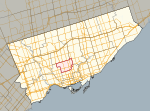Toronto—St. Paul's (provincial electoral district)

Toronto—St. Paul's is a provincial electoral district in Ontario, Canada, that has been represented in the Legislative Assembly of Ontario since 1999. Before the 2018 election, it was known simply as St. Paul's. The small but densely populated riding covers the area to the north of Downtown Toronto. The riding was represented by Liberal Eric Hoskins before his abrupt resignation on February 26, 2018. The riding was created for the 1999 election, to match the borders of the federal riding of the same name. It was carved out of the former districts of St. Andrew—St. Patrick, Eglinton, Oakwood, Dovercourt and St. George—St. David. The riding consists of part of the Fairbank, Humewood-Cedarvale, Hillcrest-Bracondale, Wychwood Park, part of Davenport, Casa Loma, Forest Hill, Tarragon Village, Rathnelly, South Hill, Summerhill, Rosehill, Chaplin Estates, Deer Park and Davisville and part of North Toronto neighbourhoods.
Excerpt from the Wikipedia article Toronto—St. Paul's (provincial electoral district) (License: CC BY-SA 3.0, Authors, Images).Toronto—St. Paul's (provincial electoral district)
Forest Hill Road, Old Toronto
Geographical coordinates (GPS) Address Nearby Places Show on map
Geographical coordinates (GPS)
| Latitude | Longitude |
|---|---|
| N 43.6958 ° | E -79.4075 ° |
Address
Forest Hill Road 160
M5P 2K3 Old Toronto
Ontario, Canada
Open on Google Maps








